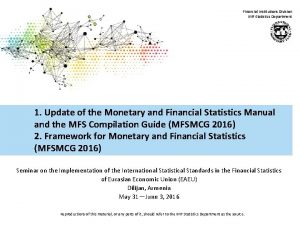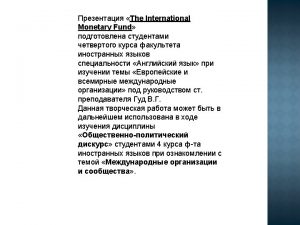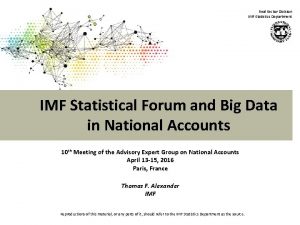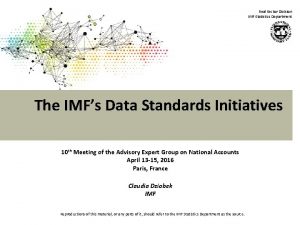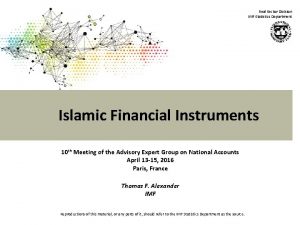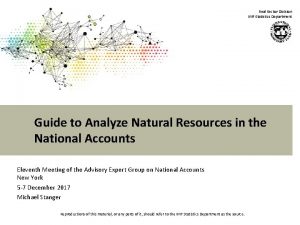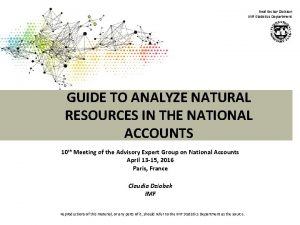Real Sector Division IMF Statistics Department 7 1







- Slides: 7

Real Sector Division IMF Statistics Department 7. 1 Economic well-being and sustainability Distributional Aspects Eleventh Meeting of the Advisory Expert Group on National Accounts New York 5 -7 December 2017 Margarida Martins Reproductions of this material, or any parts of it, should refer to the IMF Statistics Department as the source. The views expressed herein are those of the author and should not be attributed to the IMF, its Executive Board, or its management.

Real Sector Division IMF Statistics Department I. Introduction Why is inequality an important topic in the IMF? IMF research (…) has shown that rising inequality poses risks to the durability of economic growth, that the design of government policies has an impact on income distribution, and that government also can help address the situation. (IMF Annual Report 2017, Promoting Inclusive Growth) Global inequality (…) has been declining in recent decades, reflecting strong income growth in some large emerging market economies such as China and India. However, the picture of inequality within countries is mixed. (IMF, 2017 Fiscal Monitor, Tackling Inequality) 2

Real Sector Division IMF Statistics Department I. Introduction IMF Work on Operationalizing Inequality Analysis § Analytical Work § Capacity Development § Surveillance and Fund-supported programs Inequality incorporated as one element of the Fund’s policy advice § Three waves of pilot consultations • 2015/16, 2016/17, and 2017/18 • More than 25 completed pilots http: //www. imf. org/external/np/fad/inequality/ 3

Real Sector Division IMF Statistics Department II. IMF Surveillance and inequalities Armenia (2015 Art. IV Report) § Gini coefficient § Decile dispersion ratio § Growth incidence curve Kyrgyz Republic (2015 Art. IV Report) § Gini coefficient • Income inequality • Land inequality § Growth incidence curve § Income distribution by quintile 4

Real Sector Division IMF Statistics Department II. IMF Surveillance and inequalities Myanmar (2015 Art. IV Report) § Dynamic Stochastic General Equilibrium (DSGE) Model to study the macro and distributional impact of economic reforms (in this case, to examine the macro and distributional impact of financial sector reform). § Quantitatively reproduces key macroeconomic trends in the country modelled and replicates key distributional features of householdlevel data. § Two versions of the model used for Ethiopia (2015), Malawi (2015), Honduras (2016), Guatemala (2016), Bolivia (2016), and the Republic of Congo (2016). 5

Real Sector Division IMF Statistics Department III. Measuring inequality for policy advice Measuring distribution presents empirical and conceptual issues Traditional measures SNA framework > Based only on surveys § § No international standards for surveys Different definitions, units Refusal to response Short time series > Based only on tax records § § People who do not pay taxes Disposable income calculation Availability of data Measurement errors Advantage: easier to compile § Consistent measures of income, consumption, and wealth § Consistent measures across countries § Measures of income before/after redistribution § Data including informal sector and production for own-final use > Eurostat-OECD Expert Group Results show that producing data is feasible Disadvantage: resources demanding and assumptions for missing data 6

Real Sector Division IMF Statistics Department IV. Questions The AEG is requested to provide feedback on: § the inclusion of distributional measures of income, consumption, and wealth in the SNA framework. § § the need to have international agreed templates. the frequency of publishing data (for example, annual, every 3 -5 years). the resources required to produce data for the templates. particular issues pertaining to developing countries. 7

